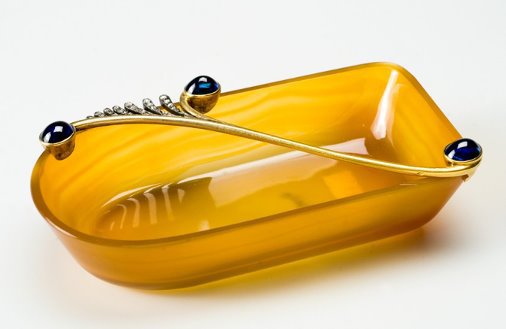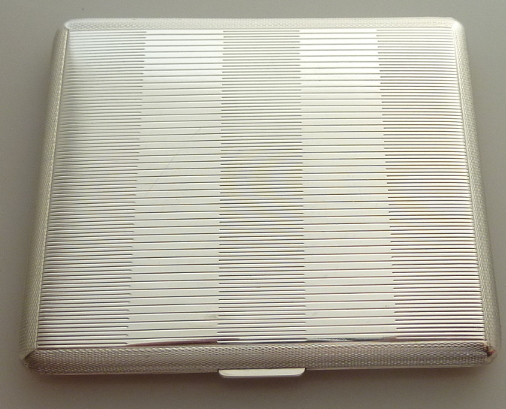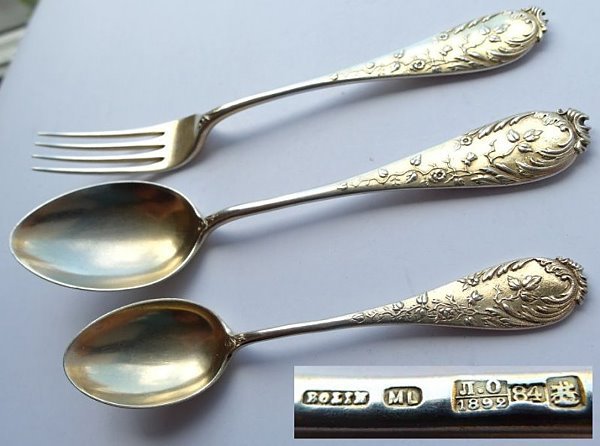W. A. Bolin
Posted: Tue Apr 10, 2018 4:46 am
Hi -
The house Bolin

When the tsarist family wanted to marry their grand duchesses at the end of the 19th and beginning of the 20th century and collect the dowry, they ordered the table silver from Fabergé and the jewelry from Bolin. This fact alone testifies to the trust in this house and the exclusivity of the orders.
The Bolins were among the oldest jewelery dynasties. Its seat in Saint Petersburg was founded by the native Saxon Andrei Rempler in 1796. He made the ascent to the court jeweler of the Emperor Paul I and Alexander I. His brother in law, the German Ernst Jan and the Swede Karl Eduard Bolin, continued his work. The name of the latter was preserved by the manufactory until today. Shortly before the revolution, one of his descendants, Vasily Bolin, decided to open a branch in Bad Homburg in Germany, at that time a popular destination for the European aristocracy. Equipped with some patterns and designs, he set off.
Лоток

But then World War I broke out and Bolin stayed in Europe. On his return via Stockholm, he agreed with a Swedish banker to found a jewelery business, the opening of which was attended by the Swedish King Gustav V. A year later, the Russian Revolution announced. The Petersburg manufactory closed its operation. But the Swedish branch of Bolin still supplies the Swedish royal family with jewelery.
The jewelry from Bolin was known for its exquisite and high-quality texture. In 1870, when the jewelers were honored again with an award from the All-Russian Exhibition, it was said in the dedication: "For the perfect purity of the jewelery, the artful matching of the stones and the fine design of the patterns during the long existence of the company." Unfortunately for this reason, very few of their works survived the revolutionary years, and the Bolsheviks tracked them down, equipped them with the requisitioned books of business, and then disassembled the stones and sold them one by one Diamonds hung on diamonds and large beads had once been made for Grand Duchess Maria Pavlovna, wife of Alexander III's younger brother.



Яйцо на подставке
Конца XIX - начала XX веков

After the revolution, it was brought with the help of British diplomats from Russia. Then it was acquired by Queen Mary, the wife of George V and grandmother of today's Queen.
Back in Stockholm he started again - this time much more modest and simple.
1919


1945



The good times were gone!
Regards
Goldstein
The house Bolin

When the tsarist family wanted to marry their grand duchesses at the end of the 19th and beginning of the 20th century and collect the dowry, they ordered the table silver from Fabergé and the jewelry from Bolin. This fact alone testifies to the trust in this house and the exclusivity of the orders.
The Bolins were among the oldest jewelery dynasties. Its seat in Saint Petersburg was founded by the native Saxon Andrei Rempler in 1796. He made the ascent to the court jeweler of the Emperor Paul I and Alexander I. His brother in law, the German Ernst Jan and the Swede Karl Eduard Bolin, continued his work. The name of the latter was preserved by the manufactory until today. Shortly before the revolution, one of his descendants, Vasily Bolin, decided to open a branch in Bad Homburg in Germany, at that time a popular destination for the European aristocracy. Equipped with some patterns and designs, he set off.
Лоток

But then World War I broke out and Bolin stayed in Europe. On his return via Stockholm, he agreed with a Swedish banker to found a jewelery business, the opening of which was attended by the Swedish King Gustav V. A year later, the Russian Revolution announced. The Petersburg manufactory closed its operation. But the Swedish branch of Bolin still supplies the Swedish royal family with jewelery.
The jewelry from Bolin was known for its exquisite and high-quality texture. In 1870, when the jewelers were honored again with an award from the All-Russian Exhibition, it was said in the dedication: "For the perfect purity of the jewelery, the artful matching of the stones and the fine design of the patterns during the long existence of the company." Unfortunately for this reason, very few of their works survived the revolutionary years, and the Bolsheviks tracked them down, equipped them with the requisitioned books of business, and then disassembled the stones and sold them one by one Diamonds hung on diamonds and large beads had once been made for Grand Duchess Maria Pavlovna, wife of Alexander III's younger brother.



Яйцо на подставке
Конца XIX - начала XX веков

After the revolution, it was brought with the help of British diplomats from Russia. Then it was acquired by Queen Mary, the wife of George V and grandmother of today's Queen.
Back in Stockholm he started again - this time much more modest and simple.
1919


1945



The good times were gone!
Regards
Goldstein




